Top Wedding Dress Fabrics: Your Ultimate Guide
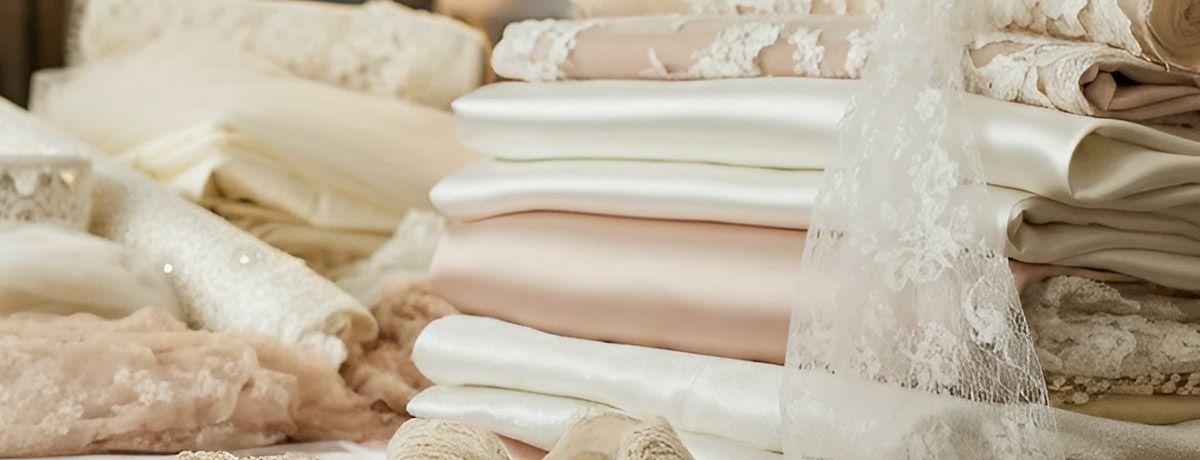
Choosing the right fabric for your wedding dress is crucial. Wedding dress fabrics, like tulle, organza, and silk, dictate the style, silhouette, and comfort of your gown. In this guide, you’ll explore the unique characteristics of popular fabrics, and learn how season, venue, and budget impact your choice. Find out how to select the perfect fabric for your special day.
Key Takeaways
-
Wedding dress fabrics greatly influence the gown’s style, silhouette, and comfort, making it essential for brides to understand their unique characteristics.
-
Factors like season, venue, and budget play a significant role in determining the best fabric choice for a wedding dress.
-
Customizing a wedding gown with layers, embellishments, and mixed textures can enhance its beauty and personal style, making it truly unique.
Understanding Wedding Dress Fabric Types
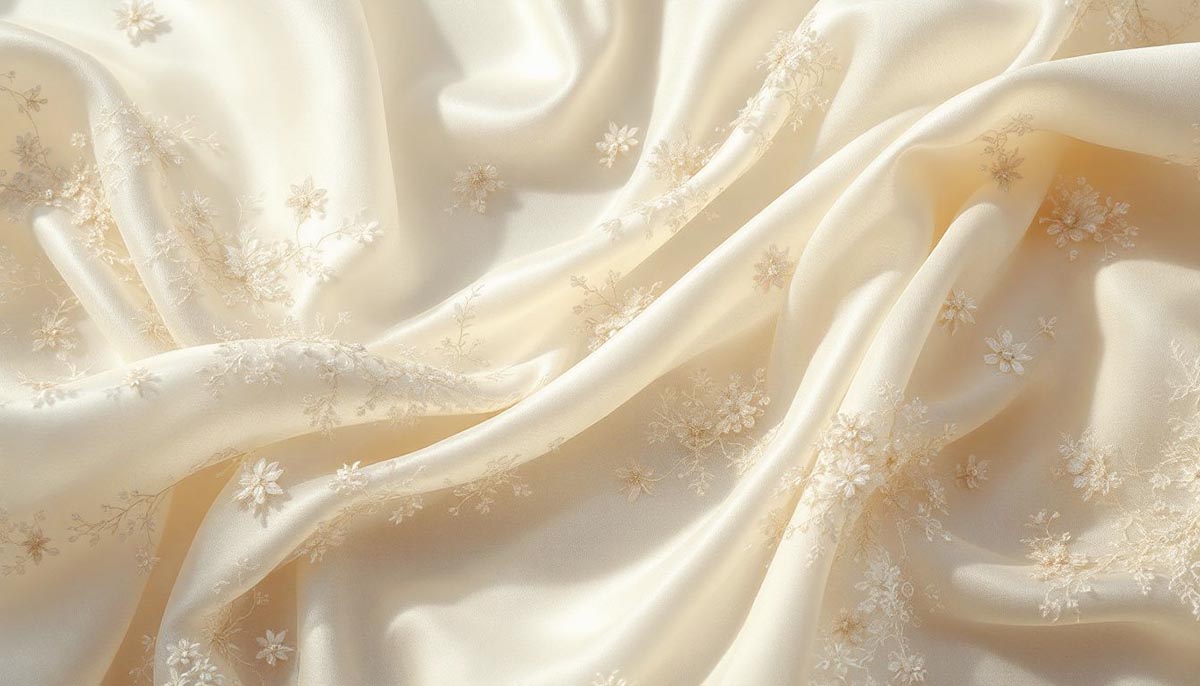
The fabric of a wedding dress is more than just a material; it’s the essence of the dress itself. It dictates the style, silhouette, and overall vibe of the gown. Common popular wedding dress fabrics include tulle, organza, silk satin, crepe, taffeta, Mikado, Duchesse satin, lace, and wedding gown fabric types. Each of these fabrics brings a unique characteristic to the dress, making it crucial to understand their properties.
Silk is often hailed as the most popular fabric for wedding gowns due to its luxurious feel and timeless elegance. Lace, on the other hand, adds intricate detail and romance, a favorite among many brides. Tulle is known for creating dreamy, voluminous skirts, enhancing the overall bridal aesthetic. The choice of fabric not only impacts the appearance but also aligns with the bride’s personal style and the wedding theme.
Selecting the right fabric affects the dress’s style, silhouette, and comfort. Explore the different types of wedding dress fabrics and their unique attributes.
Tulle
Tulle is a lightweight, airy fabric that’s perfect for creating voluminous skirts and veils. Its soft, luxurious texture drapes naturally, making it ideal for fit-and-flare, A-line, or sheath styles. Tulle is often used for gown linings, veils, and layered designs, adding a romantic touch to wedding dresses. A tulle skirt offers a dreamy, ethereal look for brides.
Stiff netting tulle can also be used to create petticoats, adding fullness and flare to gowns. This versatile fabric enhances the bridal aesthetic, making it popular among many brides.
Crepe
Crepe fabric is sleek and features a comfortable elasticity, providing a flowy appearance and slightly stretchy feel. This lightweight, matte fabric has a slightly textured, drapey effect, contributing to soft silhouettes. Pure silk crepe has a crinkled finish and slightly wavy texture, adding visual interest and making it perfect for mermaid or A-line designs.
Crepe can be crafted from soft silk or synthetic fibers like rayon, influencing its texture and drape. Stretch crepe, containing at least 5% elastane, offers flexibility and is ideal for softly structured designs like A-line, mermaid, and fit-and-flare dresses.
Silk Satin
Silk satin is renowned for its luxurious sheen and is a popular choice for formal wedding dresses. This fabric is lightweight, breathable, and drapes beautifully, contributing to a soft and elegant look. Its luxurious texture makes it perfect for constructed designs such as ruched styles or elegant ball gowns.
Whether you’re aiming for a classic or modern look, silk satin can elevate any bridal gown.
Mikado
Mikado fabric is a heavyweight, structured fabric that combines the qualities of silk and nylon. This blend offers a heavy yet structured feel suitable for tailored designs and providing necessary support and shape for ball gowns and A-line silhouettes. Mikado is structured yet soft, with a polished, wrinkle-free finish, giving it a luxurious appearance.
However, it’s important to note that Mikado is prone to creasing, which can be a consideration for long events. Despite this, Mikado remains a favored choice for brides seeking a sophisticated and structured look.
Chiffon
Chiffon is a sheer and lightweight fabric, perfect for creating ethereal wedding dress designs. Chiffon is made from woven silk or synthetic fibers such as rayon or nylon. It has a matte finish and is well-known for its transparency and breathability. Its lightweight nature makes it ideal for warm weather weddings as it promotes airflow and keeps the bride comfortable.
Chiffon is commonly used for flowing A-line and empire-waist gowns, as well as bohemian styles with diaphanous silhouettes. However, achieving fullness in a chiffon skirt requires double the usual amount of fabric.
Organza
Organza is a lightweight and structured fabric that creates volume while remaining airy, making it ideal for layered bridal looks. This fabric is perfect for whimsical dresses and can provide fullness in ball gowns, trains, and veils.
Typically woven from silk, organza results in a crisp, sheer texture that adds an elegant touch to wedding dresses.
Lace
Lace is a delicate, feminine, and romantic fabric that is versatile and works well in every shape. It provides an incredibly romantic feel, enhancing the overall aesthetic of wedding dresses. Alençon lace, a twisted corded lace, is commonly used for wedding dresses, contributing to their intricate beauty.
Lace is suitable for any silhouette, making it a popular choice for different wedding dress designs.
Factors Influencing Your Fabric Choice
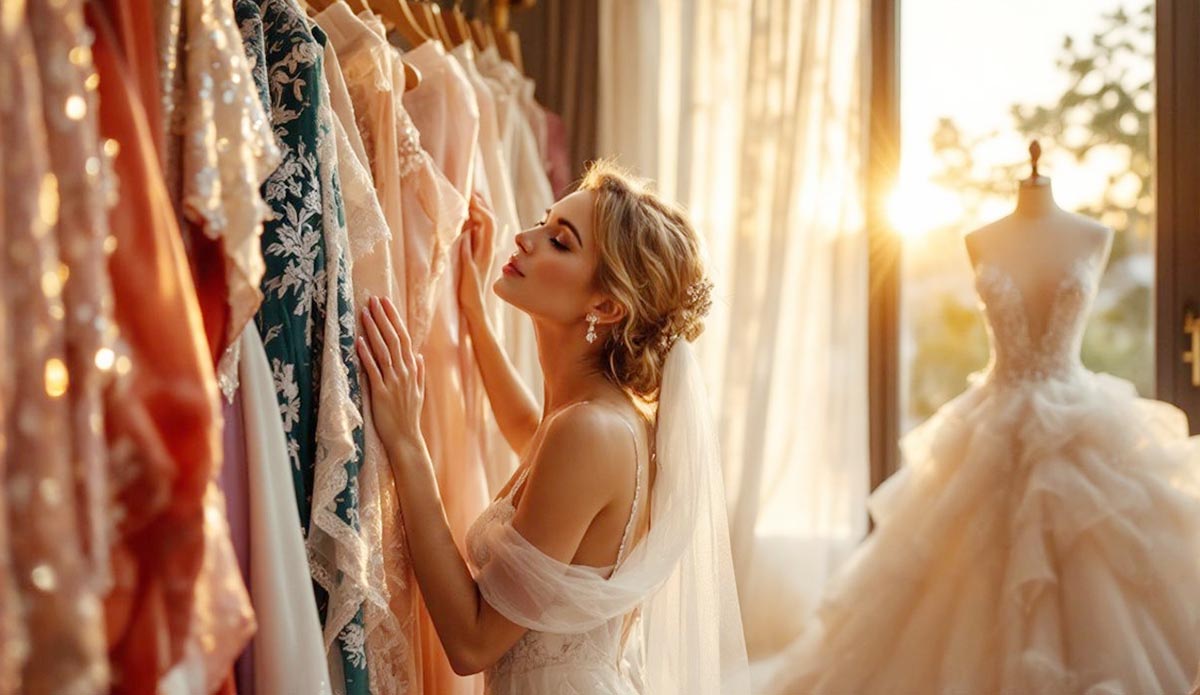
When choosing the fabric for your wedding dress, several factors come into play. The fabric significantly impacts the style and silhouette of the gown, with some materials better suited for structured designs and others for flowing looks. Your fabric choice greatly influences the overall look and feel of the gown, making it a crucial decision for brides. Consider how the fabric photographs, moves with your body, and how it makes you feel.
Several key factors influence the choice of fabric, including the style, cut, texture, drape, venue, dress code, and season. These elements can affect the comfort level during different seasons, which is crucial for your overall experience. Let’s explore these factors in more detail.
Season
The season of your wedding plays a significant role in fabric choice. For spring and summer weddings, lightweight fabrics like chiffon and tulle provide comfort and a flowing look. On the other hand, heavier materials like satin are preferred for fall and winter weddings because of their warmth.
Comfort throughout the day is paramount when selecting a transparent fabric perfect fabric.
Venue
The wedding venue can significantly influence your fabric choice. Selecting a fabric that suits the venue’s environment ensures a cohesive look. The fabric impacts not just the visual appeal but also the comfort of the bride throughout the ceremony and reception.
Carefully considering the venue when selecting fabric enhances the overall wedding day experience.
Budget
Fabric choice plays a major role in the overall cost of wedding dresses. The cost of wedding dress fabrics can vary widely, often influenced by the production methods used. Common low-cost alternatives to luxurious wedding dress fabrics include polyester, which can provide a similar look at a fraction of the cost.
Popular Fabrics for Different Dress Styles
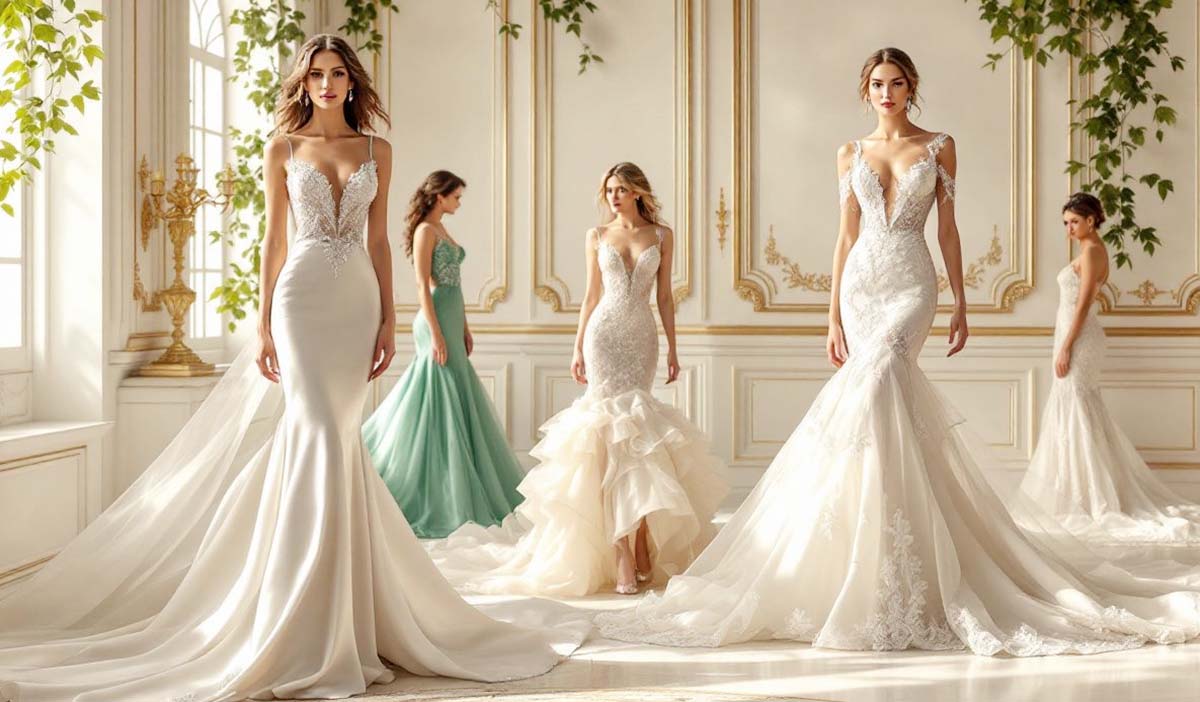
Different dress styles call for specific fabrics to achieve the desired look. Here are some fabric recommendations:
-
Mikado fabric is best suited for structured gowns, such as ball gowns and fit-and-flare silhouettes.
-
Silk satin is an excellent choice for structured A-line, mermaid, and ball gown styles, offering a luxurious feel.
-
Georgette is ideal for flowing A-line and empire-waist gowns, providing a soft and alluring drape.
Combining textured fabrics like chiffon with smoother materials can create depth and visual interest in dress designs. Utilizing different textures can significantly enhance the overall aesthetic and uniqueness of a wedding dress.
Ball Gowns
Mikado’s heavyweight and structured nature makes it ideal for ball gowns, offering support and shape for dramatic designs. Hail spot tulle is often utilized for its vintage appeal, adding texture and romantic volume to ball gowns.
The choice of fabric is crucial in creating the dramatic silhouettes typical of ball gowns.
Sheath Dresses
Recommended fabrics for sheath dresses include crepe and stretch silk satin, as they provide a sleek and flattering fit. Stretch silk satin is known for its lightweight and flowy nature, making it perfect for fitted silhouettes in sheath dresses.
Sheath dresses hug the body, creating a sleek, elegant silhouette.
A-Line Dresses
Taffeta is a structured fabric often used for A-line gowns, providing a crisp finish and elegant drape. Silk Zibeline is also suitable for A-line styled dresses, offering a luxurious look and feel. Duchess satin is ideal for A-line and ball gowns, known for its rich texture and ability to maintain shape.
Silk chiffon enhances the elegance of A-line gowns with its delicate drape, adding a soft, flowing movement.
Special Considerations for Bridal Fabrics

When choosing the fabric for your wedding dress, there are special considerations to keep in mind. The fabric choice significantly influences the wedding dress’s overall comfort and look.
Incorporating lace can add intricate detail and elegance, enhancing the uniqueness of the gown. Embellishments like beading or lace appliqués can transform a wedding gown, adding richness and texture.
Durability
Durable fabrics are crucial for wedding dresses to withstand dancing and movement throughout the event. The right bridal fabric ensures it holds up under the activity and excitement of the wedding day.
Thicker fabrics, like stretch crepe, provide extra coverage and support, enhancing the overall durability.
Comfort
Breathable fabrics like silk are ideal for keeping brides comfortable during long ceremonies. Natural fiber fabrics are generally more breathable than synthetic options, affecting comfort during warmer months.
Fabric choice affects the bride’s comfort level throughout the ceremony and reception.
Maintenance
Different fabrics require specific care techniques to maintain their quality over time. Silk and other delicate fabric may need professional cleaning to preserve their appearance.
Maintaining the quality of wedding dress fabrics is essential for both preserving their appearance and ensuring longevity.
Customizing Your Wedding Dress with Fabric Choices
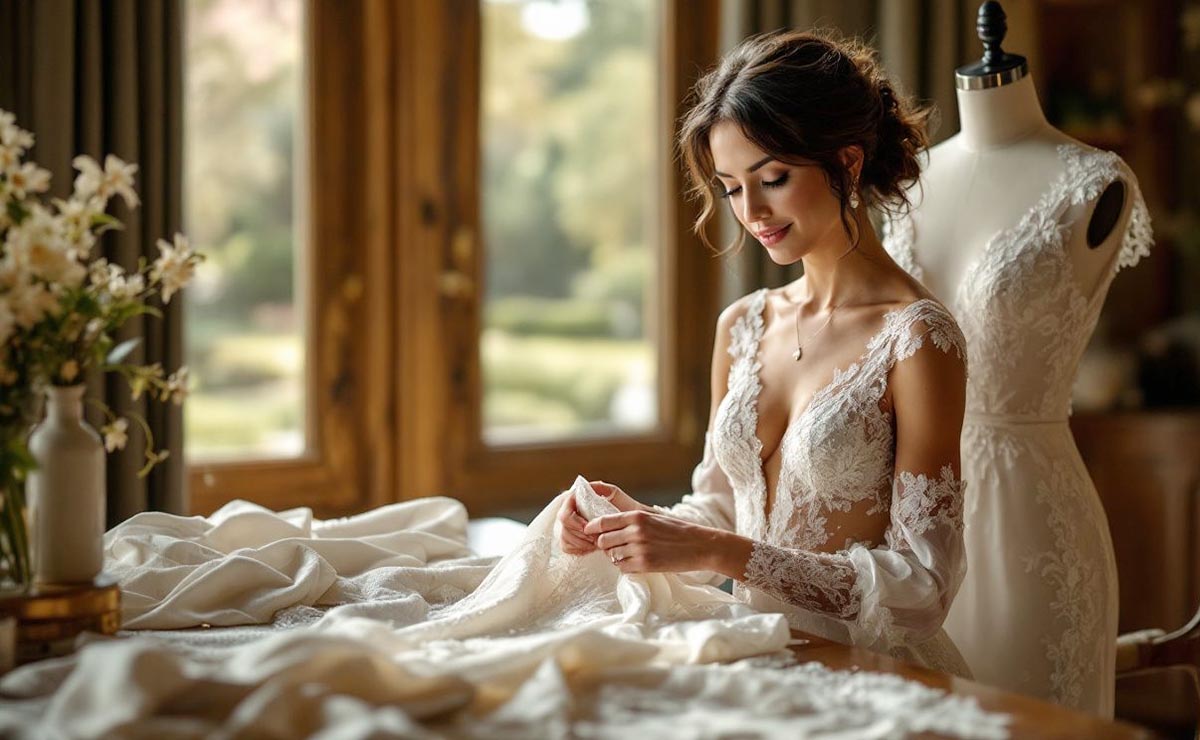
Customizing your wedding dress through fabric choices is a fantastic way to create a unique and memorable bridal look. Lace can be enhanced with beads or embroidery to add texture and detail. Personalizing your wedding dress through thoughtful fabric selection and embellishments can transform a standard dress into a stunning gown.
Using embellishments like lace and beading can significantly enhance the beauty and intricacy of the dress.
Adding Layers
Layers can enhance volume and create a more dramatic silhouette in a wedding dress. Tulle is a lightweight, airy fabric perfect for creating voluminous skirts and veils; it adds a romantic touch to wedding dresses.
Organza is another excellent option for layering, as it creates volume without adding too much weight.
Embellishments
Beading can add sparkle and sophistication, making any fabric selection more luxurious. Pearls are currently a trending embellishment for bridal gowns, often combined with crystals for a more elaborate look.
Heavily embellished trims often include beads, sequins, and diamantes, which can be used to create unique designs on wedding dresses.
Mixing Textures
Combining silk satin and chiffon can create a dynamic appearance, enhancing the gown’s overall design. Combining textures in wedding dress designs adds depth and interest, showcasing the bride’s unique style.
This blend not only enhances visual appeal but also allows for a highly personalized wedding gown that reflects the bride’s taste.
Summary
Choosing the right fabric for your wedding dress is a crucial step in achieving your dream bridal look. From understanding the unique characteristics of popular wedding dress fabrics to considering factors like season, venue, and budget, fabric choice significantly impacts both the aesthetic and comfort of your gown. Personalizing your dress through thoughtful fabric selection and embellishments can create a unique and memorable look, ensuring you feel as stunning as you look on your special day.
Frequently Asked Questions
What is the best fabric for a summer wedding dress?
Chiffon and tulle are great choices for a summer wedding dress because they're lightweight and breathable, ensuring you stay cool and comfy on your big day.
How do I choose the right fabric for my wedding dress?
Choosing the right fabric for your wedding dress really depends on the season, venue, and your personal style. Think about the feel of different fabrics to find one that matches your vision and comfort!
Can I mix different fabrics in my wedding dress?
Absolutely, mixing fabrics like silk satin and chiffon can give your wedding dress a unique look and feel. It’s a great way to express your personal style!
How do I maintain the quality of my wedding dress fabric?
To maintain the quality of your wedding dress fabric, make sure to use the right care techniques based on its material—professional cleaning for delicate fabrics like silk and gentle cleaning for sturdier ones. Proper storage is key, so hang or fold your dress carefully to prevent damage.
What are some cost-effective alternatives to luxurious wedding dress fabrics?
Polyester is a great budget-friendly alternative that mimics the look of luxurious fabrics like silk and satin without breaking the bank. It's perfect for achieving elegance at a lower price!
Resources Page
- The Magic of Wedding Dress Texture: The Fabric Factor
- Dressmaking Fabrics 101 for Sewing
- Fabric for Formal Dresses: Beyond the Aisle and Dance Floor Choices for Unforgettable Dresses
- Fabrics for Dress: Linen by the Yard
- The Fabric for Special Occasions: The Formula for Show-Stopping Wear
- Timeless Elegance: Wedding Dress Fabric for Sale for Your Big Day
- Wholesale Wedding Fabric The Seam Behind Every Dream Dress
- Weaving Dreams with Wedding Theme Fabric
- Bridal Dress Fabrics for Designers and Manufacturers
